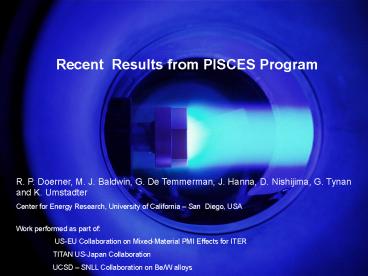Recent PISCES Results - PowerPoint PPT Presentation
1 / 18
Title: Recent PISCES Results
1
Recent Results from PISCES Program R.
P. Doerner, M. J. Baldwin, G. De Temmerman, J.
Hanna, D. Nishijima, G. Tynan and K. Umstadter
Center for Energy Research, University of
California San Diego, USA Work performed as
part of US-EU Collaboration on Mixed-Material
PMI Effects for ITER TITAN US-Japan
Collaboration UCSD SNLL Collaboration on Be/W
alloys
2
Outline - Recent PISCES Results
- Erosion of Be layers
- Laser irradiation of plasma exposed targets
- Preparation for ELM simulation studies
- Be/W formation conditions
- Mixed species (D/He) plasma studies
- W exposure to mixed species plasma
- Impact of Be and C impurities on W surface
evolution - Codeposition studies (presented tomorrow)
- Summary
3
PISCES-B has been modified to allow exposure of
samples to Be seeded plasma
P-B experiments simulate Be erosion from ITER
wall, subsequent sol transport and interaction
with W baffles or C dump plates, as well
as investigation of codeposited materials using
witness plates
4
Plasma deposited Be (from oven) erodes
differently than other Be layers
- Erosion calibration measurements for JET ILW
erosion marker tiles - Plasma deposited Be is easily re-eroded from
deposited locations (remember for tomorrow) - Erosion of Be from Be2C are underway
5
ELM simulation experiments are beginning, using
laser irradiation of plasma exposed targets
- Laser heating method allows use of background
plasma as diagnostic tool - High-speed diagnostics implemented using 750mJ
YAG laser (0.5 nsec) - 10000 fps, 10 msec camera, also single frame
2-100 nsec camera - Gated imaging spectrometer w/ ICCD (50 nsec gate)
- Hydrogen saturation of surface produces much
different effects - Macroscopic material ejection observed both ww/o
plasma - 10x more material lost from plasma exposed
samples during laser shots - Laser irradiation of samples can induce plasma
arcing (e- emission?) - Acquired welding laser capable of simulating ELM
conditions - 1.5 50 J, 0.3 10 msec adjustable pulse, fiber
delivery to P-B
6
Stable Be-W alloys are known and have melting
points closer to that of Be than W.
- Stable Be-W inter-metallics are
- 2200C (Be2W)
- 1500C (Be12W)
- 1300C (Be22W)
- What will happen if Be transport into the W bulk
is rapid enough that alloy formation is not
limited to the near surface?
Stable Be-W alloys
2
7
XPS confirms Be-W alloy formation on W target
surfaces exposed in range 850-1320 K.
- Be-W alloy line shifts are consistent
withWiltner Linsmeier,JNM 337339 (2005)
D ion fluence 1.2x1026 m-2nBe/ne 0.1 ,
8
The availability of surface Be is found to be
critical for Be-W alloy formation (Dt 1 h).
- A 0.3 mm Be12Wlayer forms at W-Beinterface.
- Be12W nucleationon W rich surface.
- No Be sub-surface.
9
Similar layered structure observed in SNLL vacuum
deposition measurements
10
(No Transcript)
11
Be re-erosion and evaporation reduce surface Be
availability, reducing alloy formation rate.
- Surface composit-ion below stoichio-metry for
Be2W. No Besub-surface.
- Be12W surfacenucleation over almostidentical
surface to (d).
12
Simple particle transport model predicts Be
overlayer formation (most efficient
alloying). More detailed modeling needed.
Values taken from W. Eckstein, IPP Report 9/17,
(1998)D. R. Lide, CRC Handbook of Chem. Phys.,
Internet Version (2005)
13
Mixed D-Be/C-He on W experimentsEffects of He
and D-He plasma on W.Influence of plasma
impurities Be and C on these effects.
14
Plasma simulators observe morphology change on W
surfaces exposed to pure He plasma.
PISCES-B pure He plasma
NAGDIS-II pure He plasma
Ts 1200 K, Dt 4290 s, Fluence 2x1026
He/m2, Ei 25 eV
Ts 1250 K, Dt 36,000 s, Fluence 3.5x1027
He/m2, Ei 11 eV
N. Ohno et al., in IAEA-TM, Vienna, 2006
Transmission electron microscope (TEM) in Kyushu
Univ.
Scanning electron microscope (SEM)
15
Effect of D2-He plasmas at Ts 1100-1200 K.
D2-He plasma, Ei 60 eV nHe/ne 10 Dt
4200 s1025 He/m2
He plasma, Ei 60 eV Dt 420 s1025 He/m2
He plasma, Ei 25 eV Dt 4290 s2x1026
He/m2
- Plasma exposure time, Dt, is a stronger
influence than He ion flux or fluence
16
D2-He mixture plasma w/wo Be induces morphology
on W at Ts 1100 K Ei 60 eV.
Ei 60 eV, Ts 1100 K, Fluence 1025 He/m2
D2-He plasma
D2-He plasma with Be
nHe/ne 10 , nBe/ne 0.2 , Dt 4200 s
nHe/ne 10 , Dt 4200 s
Finger-like structures observed, similar to pure
He plasma
Ion bombardment at Ei 60 eV prevents Be layer
growth.
But, Be somewhat inhibits morphology.
17
Be or C plasma impurities can inhibit morphology
at Ts 1100 K Ei 15 eV.
Ei 15 eV, Ts 1100 K, Fluence 1025 He/m2
D2-He plasma with Be
D2-He plasma with C
nHe/ne 10 , nBe/ne 0.5 , Dt 5000 s
nHe/ne 10 , nC/ne lt 0.1 , Dt 3600 s
Surface layer composition determined by x-ray
microanalysis (WDS).
At Ei 15 eV, Be and C deposited on W are not
sputtered away.
Be-W alloy and W-C layers inhibit He induced
morphology.
18
In conclusion
- Tungsten as PFM has unique issues for an all-W
ITER, and beyond - Mixed-material issues are critical, even in a
device with only one element as a PFM - Helium ash, Argon/Neon radiator gas, Oxygen
- How will mixed-species plasmas effect Be
mitigation of C chemical erosion - Stay tuned for tomorrows discussion on
codeposition (and the role of mixed species
plasmas there)

